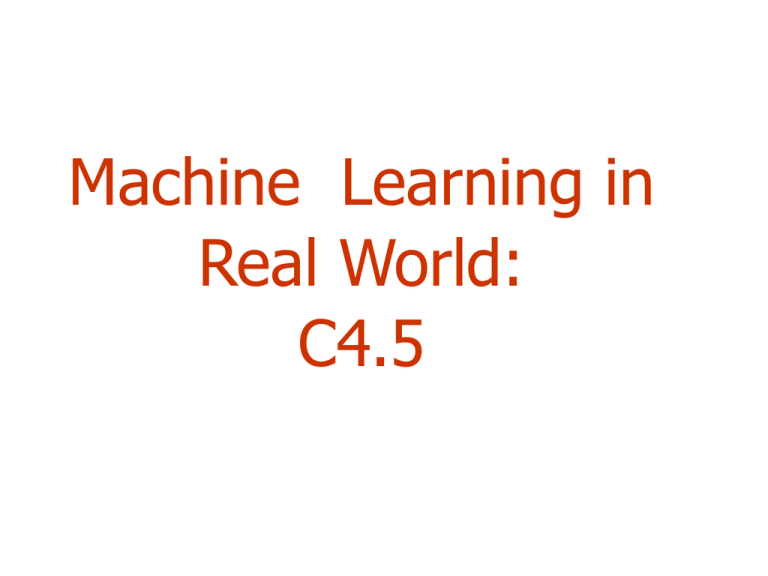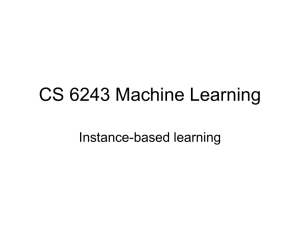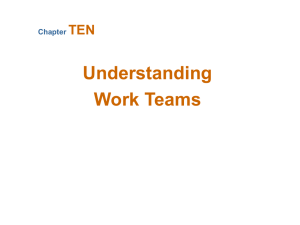DM7: Classification: C4.5
advertisement

Machine Learning in Real World: C4.5 Outline Handling Numeric Attributes Finding Best Split(s) Dealing with Missing Values Pruning Pre-pruning, Post-pruning, Error Estimates From Trees to Rules 2 Industrial-strength algorithms For an algorithm to be useful in a wide range of realworld applications it must: Permit numeric attributes Allow missing values Be robust in the presence of noise Be able to approximate arbitrary concept descriptions (at least in principle) Basic schemes need to be extended to fulfill these requirements witten & eibe 3 C4.5 History ID3, CHAID – 1960s C4.5 innovations (Quinlan): permit numeric attributes deal sensibly with missing values pruning to deal with for noisy data C4.5 - one of best-known and most widely-used learning algorithms Last research version: C4.8, implemented in Weka as J4.8 (Java) Commercial successor: C5.0 (available from Rulequest) 4 Numeric attributes Standard method: binary splits E.g. temp < 45 Unlike nominal attributes, every attribute has many possible split points Solution is straightforward extension: Evaluate info gain (or other measure) for every possible split point of attribute Choose “best” split point Info gain for best split point is info gain for attribute Computationally more demanding witten & eibe 5 Weather data – nominal values Outlook Temperature Humidity Windy Play Sunny Hot High False No Sunny Hot High True No Overcast Hot High False Yes Rainy Mild Normal False Yes … … … … … If outlook = sunny and humidity = high then play = no If outlook = rainy and windy = true then play = no If outlook = overcast then play = yes If humidity = normal then play = yes If none of the above then play = yes witten & eibe 6 Weather data - numeric Outlook Temperature Humidity Windy Play Sunny 85 85 False No Sunny 80 90 True No Overcast 83 86 False Yes Rainy 75 80 False Yes … … … … … If outlook = sunny and humidity > 83 then play = no If outlook = rainy and windy = true then play = no If outlook = overcast then play = yes If humidity < 85 then play = yes If none of the above then play = yes 7 Example Split on temperature attribute: 64 65 68 69 Yes No Yes Yes 70 71 72 Yes No No 72 75 Yes Yes 75 80 81 83 Yes No Yes Yes No E.g. temperature 71.5: yes/4, no/2 temperature 71.5: yes/5, no/3 Info([4,2],[5,3]) = 6/14 info([4,2]) + 8/14 info([5,3]) = 0.939 bits Place split points halfway between values Can evaluate all split points in one pass! witten & eibe 8 85 Avoid repeated sorting! Sort instances by the values of the numeric attribute Time complexity for sorting: O (n log n) Q. Does this have to be repeated at each node of the tree? A: No! Sort order for children can be derived from sort order for parent Time complexity of derivation: O (n) Drawback: need to create and store an array of sorted indices for each numeric attribute witten & eibe 9 More speeding up Entropy only needs to be evaluated between points of different classes (Fayyad & Irani, 1992) value 64 class Yes 65 68 69 No Yes Yes 70 71 72 Yes No No 72 75 Yes Yes 75 80 81 83 85 Yes No Yes Yes No X Potential optimal breakpoints Breakpoints between values of the same class cannot be optimal 10 Binary vs. multi-way splits Splitting (multi-way) on a nominal attribute exhausts all information in that attribute Nominal attribute is tested (at most) once on any path in the tree Not so for binary splits on numeric attributes! Numeric attribute may be tested several times along a path in the tree Disadvantage: tree is hard to read Remedy: witten & eibe pre-discretize numeric attributes, or use multi-way splits instead of binary ones 11 Missing as a separate value Missing value denoted “?” in C4.X Simple idea: treat missing as a separate value Q: When this is not appropriate? A: When values are missing due to different reasons Example 1: gene expression could be missing when it is very high or very low Example 2: field IsPregnant=missing for a male patient should be treated differently (no) than for a female patient of age 25 (unknown) 12 Missing values - advanced Split instances with missing values into pieces A piece going down a branch receives a weight proportional to the popularity of the branch weights sum to 1 Info gain works with fractional instances use sums of weights instead of counts During classification, split the instance into pieces in the same way witten & eibe Merge probability distribution using weights 13 Pruning Goal: Prevent overfitting to noise in the data Two strategies for “pruning” the decision tree: Postpruning - take a fully-grown decision tree and discard unreliable parts Prepruning - stop growing a branch when information becomes unreliable Postpruning preferred in practice— prepruning can “stop too early” 14 Prepruning Based on statistical significance test Stop growing the tree when there is no statistically significant association between any attribute and the class at a particular node Most popular test: chi-squared test ID3 used chi-squared test in addition to information gain witten & eibe Only statistically significant attributes were allowed to be selected by information gain procedure 15 Early stopping a b class 1 0 0 0 2 0 1 1 3 1 0 1 4 1 1 0 Pre-pruning may stop the growth process prematurely: early stopping Classic example: XOR/Parity-problem No individual attribute exhibits any significant association to the class Structure is only visible in fully expanded tree Pre-pruning won’t expand the root node But: XOR-type problems rare in practice And: pre-pruning faster than post-pruning witten & eibe 16 Post-pruning First, build full tree Then, prune it Fully-grown tree shows all attribute interactions Problem: some subtrees might be due to chance effects Two pruning operations: 1. Subtree replacement 2. Subtree raising Possible strategies: error estimation significance testing MDL principle witten & eibe 17 Subtree replacement, 1 Bottom-up Consider replacing a tree only after considering all its subtrees Ex: labor negotiations witten & eibe 18 Subtree replacement, 2 What subtree can we replace? 19 Subtree replacement, 3 Bottom-up Consider replacing a tree only after considering all its subtrees witten & eibe 20 Estimating error rates Prune only if it reduces the estimated error Error on the training data is NOT a useful estimator Q: Why it would result in very little pruning? Use hold-out set for pruning (“reduced-error pruning”) C4.5’s method witten & eibe Derive confidence interval from training data Use a heuristic limit, derived from this, for pruning Standard Bernoulli-process-based method Shaky statistical assumptions (based on training data) 22 *Mean and variance Mean and variance for a Bernoulli trial: p, p (1–p) Expected success rate f=S/N Mean and variance for f : p, p (1–p)/N For large enough N, f follows a Normal distribution c% confidence interval [–z X z] for random variable with 0 mean is given by: Pr[ z X z ] c With a symmetric distribution: Pr[ z X z ] 1 2 Pr[ X z ] witten & eibe 23 *Confidence limits Confidence limits for the normal distribution with 0 mean and a variance of 1: –1 0 1 1.65 Pr[X z] z 0.1% 3.09 0.5% 2.58 1% 2.33 5% 1.65 10% 1.28 20% 0.84 25% 0.69 40% 0.25 Thus: Pr[ 1 . 65 X 1 . 65 ] 90 % To use this we have to reduce our random variable f to have 0 mean and unit variance witten & eibe 24 *Transforming f f p Transformed value for f : p (1 p ) / N (i.e. subtract the mean and divide by the standard deviation) Resulting equation: Pr z Solving for p: 2 z p f z 2N witten & eibe 25 z c p (1 p ) / N f p 2 N N 4N f f 2 z 2 z 1 N 2 C4.5’s method Error estimate for subtree is weighted sum of error estimates for all its leaves Error estimate for a node (upper bound): 2 z e f z 2N 2 N N 4N f f 2 z 2 2 z 1 N If c = 25% then z = 0.69 (from normal distribution) f is the error on the training data N is the number of instances covered by the leaf witten & eibe 26 Example f = 5/14 e = 0.46 e < 0.51 so prune! f=0.33 e=0.47 witten & eibe f=0.5 e=0.72 f=0.33 e=0.47 Combined27using ratios 6:2:6 gives 0.51 From trees to rules – how? How can we produce a set of rules from a decision tree? 29 From trees to rules – simple Simple way: one rule for each leaf C4.5rules: greedily prune conditions from each rule if this reduces its estimated error Can produce duplicate rules Check for this at the end Then look at each class in turn consider the rules for that class find a “good” subset (guided by MDL) Then rank the subsets to avoid conflicts Finally, remove rules (greedily) if this decreases error on the training data witten & eibe 30 C4.5rules: choices and options C4.5rules slow for large and noisy datasets Commercial version C5.0rules uses a different technique Much faster and a bit more accurate C4.5 has two parameters Confidence value (default 25%): lower values incur heavier pruning Minimum number of instances in the two most popular branches (default 2) witten & eibe 31 Summary Decision Trees splits – binary, multi-way split criteria – entropy, gini, … missing value treatment pruning rule extraction from trees Both C4.5 and CART are robust tools No method is always superior – experiment! witten & eibe 36







